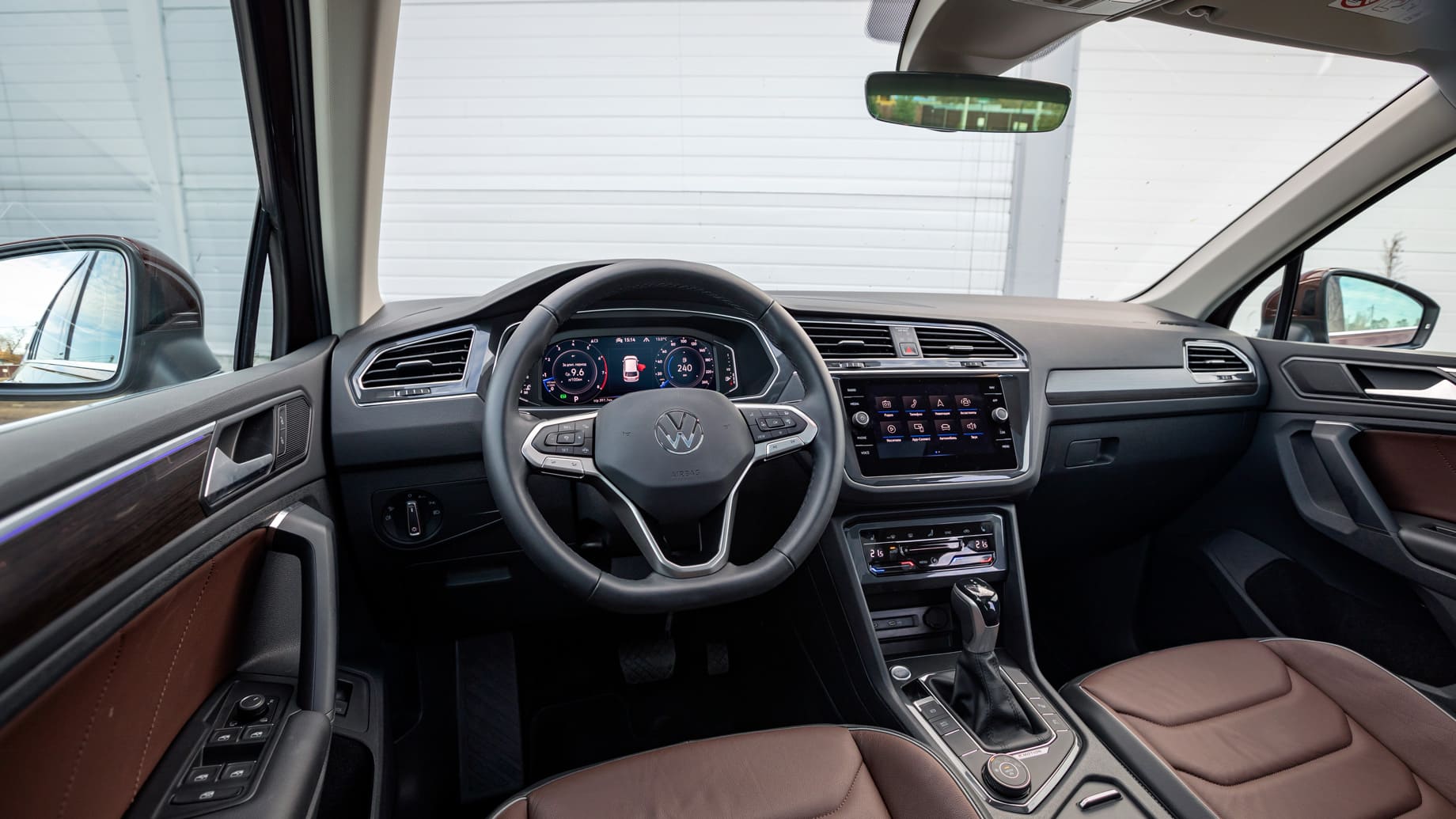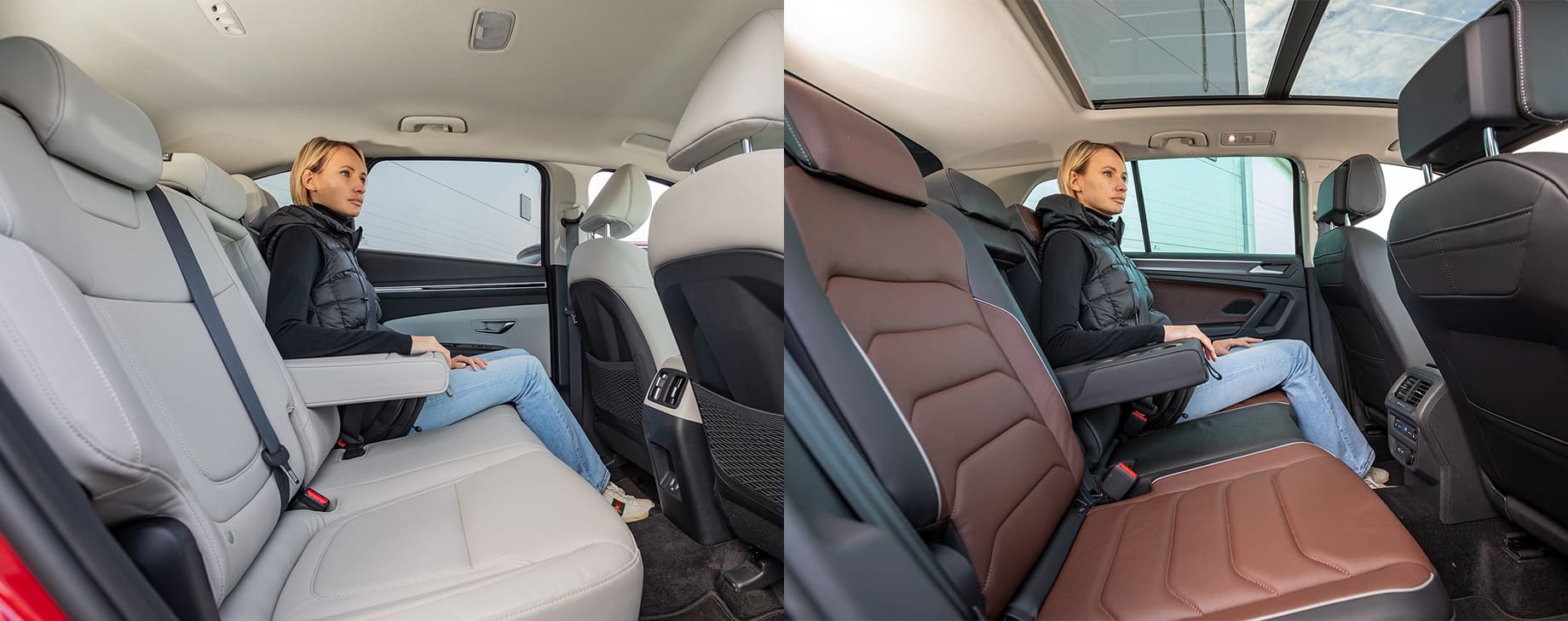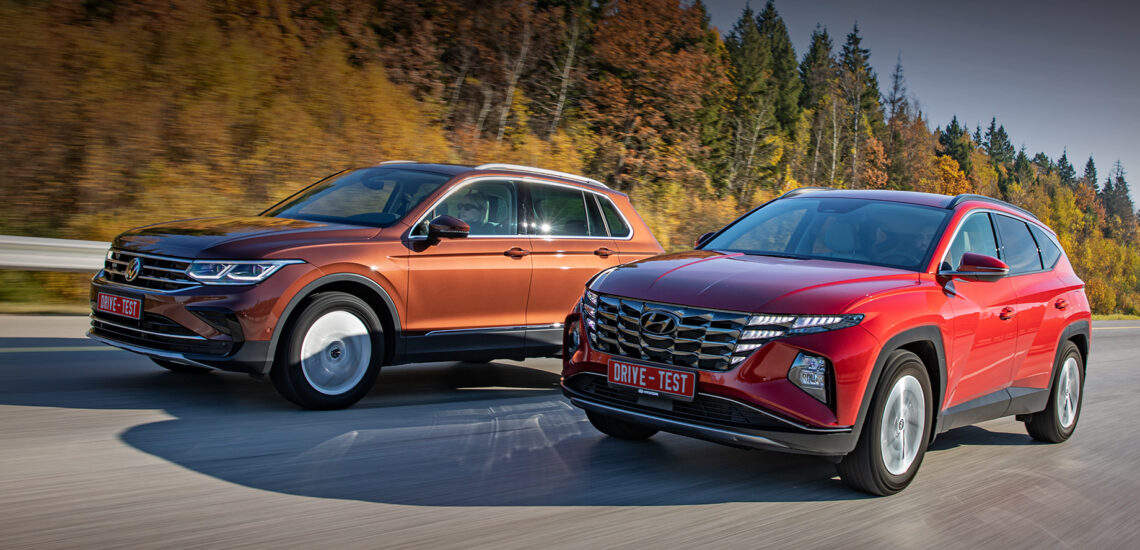South Korea vs Germany, Hyundai vs Volkswagen — looks like we’ve already know the winning side. Nice looking outside appearance, good equipment and barely tuned chassis — that’s how the new Tucson appears. The renewed Tiguan is definitely better than the previous one. Don’t rush to conclusions — the stereotype is not as tenacious as it seems.
Tucson impresses with its futuristic appearance in pictures, but in reality the front end with a radiator grill garland and running lights are getting lost. The the car back-end LED light blade and waffle insert at the bottom of the bumper don’t impress either. The details themselves are interesting, but together they seem garish. Tiguan, however, doesn’t have that kind of problem.

Both test crossovers are of the same class, although they differ greatly in size. This is noticeable even to the eye — next to the Tucson, the Tiguan looks like a raised hatchback next to a full-fledged crossover. No wonder the Hyundai is 4.6 inches longer, 1.02 inches wider and has a 2.99 inches longer wheelbase.
However, this does not provide advantages for placement. Both crossovers have doors that open wide, the thresholds are not very wide, just as not high from the ground, but the Tucson front doorways are smaller than those of the Volkswagen. However, the Hyundai doors completely cover the sides of the body from below, whereas in Tiguan there is always a strip of dirt along the thresholds.
The Tucson elegant interior wins at night, when the frameless digital instrument panel with interchangeable themes, and a widescreen display, successfully inscribed in the basalt of the center console, are especially effective. During the day, plastic of various textures catches the eye — it looks not that expensive in appearance, regardless of the degree of compliance. The finish also uses fabric dust collector inserts and glossy black elements with metal-like edging.

There are enough physical convenient-to-use buttons in the cabin. Ergonomic cluster near the gear lever, the heating keys of the front seats and the steering wheel are right beneath your hand. Touch panels do not always respond to the touch, whether it is a dual-zone climate control unit or a multimedia system screen. Picture is of the high quality, the application icons are perfectly drawn, and the menu pages scroll without any jerks and delays. Navigation, Android Auto and Apple CarPlay protocols work quite quickly.
Tiguan interior is boring, the instrument display is clumsily integrated into the prompter box above the steering wheel. The wood imitation used in the decoration is implausible. But in general, the German interior is better, build quality is higher, and you can feel care in little things. Three-stage heated steering wheel is delicate, unlike the scalding single-mode in Tucson. Both front seats are electrically adjustable with settings memorizing, while Hyundai only offers power adjustments to the driver and does not remember them after.
Tiguans central touchscreen is located conveniently, and reacts faster on touch. The work speed of multimedia is analogous, but the menu symbols are bigger, images are more colorful, Android Auto and Apple CarPlay connection is faster. Although, the screen resolution is not that good — grain is clearly visible on the glossy screen.

The exact same problem has the drawn dashboard, but it still pleases with a large number of options for displaying information. For example, the navigation map can be displayed on the entire display. Ergonomic flaws include the climate touch control and the conflict of the adjustable armrest with the gear lever and the hollow disk for changing driving modes.
The sitting in Tiguan is visibly lower, the hood is worse visible. The side mirrors are a bit smaller, A-pillars are thinner, the visibility throughout the back rear glass is the best. The front seats are great. The padding of the central part of the back and cushion are soft, the developed lateral support rollers are dense — the excellent combination. Front headrests can be regulated in different directions, just as the lumbar support. Its height in Tucson didn’t change.
In Tucson, the sitting is truly crossover-like. In the lower seat position, you look over the front panel and hood, sense the overall size better. The visibility is good, although the left front windscreen wiper, just as in Volkswagen, doesn’t reach the left A-pillar pretty much. The normal-length cushioned seat is also comfortable, even though the padding is thicker than in the Volkswagen. However, lateral support doesn’t come to the front. A serious claim is only for the almost stone-like headrests.
Tucson’s advantage here is the second row. The rear door openings are wide, the roof edge and the wheel arch do not interfere with the landing. It’s very spacious inside: behind the driver’s seat adjusted to my height, which is 5’9 , I sit down with a gap of 4.33 inches at the knees and 4.72 inches above my head. The cozy sofa is not longitudinally adjustable, but the backrest leans back by such a large angle, that in the extreme position you are almost lying down, enjoying the space for your feet. The third passenger can put his feet on a wide floor tunnel.

The Tiguan opening is higher and allows you to enter the interior without bending down too much. The second row seat is a bit softer and wider at elbow level. Unfortunately, it’s not so clearly molded — the back is flat. The space in front of the legs and above the head is noticeably smaller (3.15 and 3.54 inches), the central tunnel is high and narrow, the backrest is adjustable in the angle of inclination in a very small range. However, the trunk size can be increased by moving the rear seat closer to the front seats.
Futuristic Tucson is equipped with a simple power unit. Let the two-liter atmospheric V4 belong to the new Smartstream family, but it produces the same 150 h.p. as its predecessor, working in conjunction with the well-deserved six-speed automatic gearshift. According to the passport, an all-wheel drive Hyundai goes up to 62 miles/h within 11.6 seconds, but our Racelogic counted 12.1 with two pedals starting. If you accelerate with the transfer of the leg, then the time will worsen by another two tenths of a second.
Life is glimmering at 5000 rpm, but below and in the zone of average revs, there is not enough thrust. Overtaking on country roads is difficult for Tucson, even with the throttle fully open. At first, the accelerator is sensitive, but almost immediately the pedal connection becomes less linear — you get acceleration after a noticeable pause, lift your foot off the pedal — the car accelerates for another second and a half. Going one step down takes the automatic gearshift so much time, that you already changed your mind to accelerate.
The 1.4-liter turbocharged engine produces the same 150 h.p., but 250 Nm are available at 1500-3500 rpm range, while 192 Nm of Tucson account for 4500 rpm. And if the Korean car with automatic gearshift does not have its own sport mode, then the DQ250 preselective with a pair of wet clutches also offers a full-fledged launch control. Starting with two pedals, the Tiguan gains 62 miles/h in 9.9 seconds, yielding only one tenth of the declared time.

Relatively emotional acceleration under the vacuum-cleaner-like buzz of the engine is accompanied by shock shifts. Without a launch, the Tiguan needs 10.7 seconds, a second and a half less than the Tucson. In the city, the sporty settings of the power unit make Volkswagen look like, if not a “hot” hatchback, then a “warmed up” one for sure. The power unit is elastic, the “robot” is responsive and provides excellent communication on the accelerator. The V4 pulls decently on the highway up to 93 miles/h.
The moderately sharp steering wheel, which conveys in detail what is happening on the road, is not obscured by excessive effort. Tiguan willingly stands on an arc, quickly choosing a roll, and does not jump off the trajectory if bumps get under the wheels. When going through the speed, it smoothly goes to the outer radius, and under the gas reset in ESC Sport mode, it can easily be set sideways. In standard mode, the safety electronics do not allow this, quickly preventing both the rear axle failure and oversteer.
Tucson lurches harder, although not too much. The response to the steering wheel is not so fast, intensifying a significant parasitic background, but in extreme modes it allows you to feel the moment when the front wheels stop responding correctly. Without the stabilization system support, the crossover smoothly moves a bonnet to the side, reacting weakly to the actions of the steering wheel and accelerator. This is why the electronics should always be turned on — it’s the only thing that can get Hyundai back to the turn.
The most surprising thing in Tucson is its smooth driving, which is, obviously, its strongest characteristic. The first thing you notice is how confident it is on a road full of bumps. The usual for Hyundai cars rocking caused by the repetition of the profile is much less, as well as vibrations. On the bad piece of road, Tucson goes without breakdowns and laxity.
It almost completely ignores the microprofile, smoothly driving on small and medium-sized irregularities, it steadfastly withstands a meeting with joints. You can run into a dense blow in two cases: if you don’t slow down in front of a “speed bump” or get into a deep pit with a sharp edge at a high speed. Even on off-road Hyundai can go on a high speed, keeping its smooth driving.

Tiguan is also immuned to road ripples, but rides harder on most city pits. It carefully overcomes large pits and artificial urban irregularities at any speed. However, the pleasure of a good chassis balance kills the acoustic accompaniment of the suspension. It rumbles on almost any bump, especially at the joints between concrete slabs, the ears are suffering.
As soon as you drive onto an uneven grader, breakdowns are added to the suspension noise, although the steering wheel is better isolated from bumps and shocks. To be more serious off-road the German car has larger clearance than the Tucson, and better geometric patency. Tiguan definitely clings to the bottom of the ground less often and drives more confidently in the mud, until it completely clogs the asphalt tires.
Great support is off-road traction control, the benefits of which are perfectly demonstrated by cross-axling. With this off-road program turned on, Tiguan is driving forward immediately. But when it turned off, the car skids. The rear-wheel drive clutch does not overheat, but the “robot” turns out to be the thin spot — with moderate fuel supply, Volkswagen shakes until the transmission shock with the gear off forces it to roll back. As if the DSG severs the connection with the motor, fearing for the “health” of the nodes.
Hyundai spends more time overcoming mud baths: it skids more and moves slower. However, the suspension moves are larger and, unlike Tiguan, Tucson allows you to forcibly lock the multi-disc clutch. And when one or two wheels are hanging in the air, the car is not without difficulties, but gets out of this situation. Moreover, after a long slip, the Korean clutch also remains operational.

The new Hyundai has made such a leap that comparison with the Tiguan no longer puts the “Korean” in a deliberately vulnerable position. Tucson looks more interesting from the outside and inside, is not inferior in comfort on the road, and off-road driving is more pleasant. The equipment is competitive, electronic assistants are configured better. The adaptive cruise-control with the Lane Assist could set an example to the new Genesises.
Still, Tucson has only evolved to the European norm in driving disciplines. The balanced chassis of the Tiguan sets a higher bar. The turbo engine plays in a different league. The preselective “robot” is poorly prepared for off-road, and the acoustic support of the suspension is just a failure. I don’t remember this on any MQB model.
This is a translation. You can read the original here: https://www.drive.ru/test-drive/hyundai/volkswagen/618d333830bd69250e250fc8.html

Published April 21, 2022 • 9m to read






